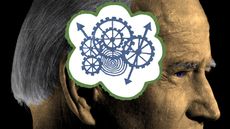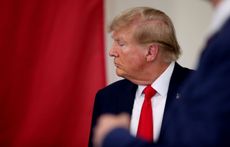Down to the wire
This year’s presidential election might well ï¬ t into a storied tradition of Election Day nail-biters.
When was the first close one?
The U.S. has had close—and bitterly disputed—elections since the earliest days of the union. In 1800, Federalist incumbent John Adams was beaten by two Republican candidates, Thomas Jefferson and Aaron Burr. But those two tied for the number of Electoral College votes, so it fell to Congress to decide whether the president should be Jefferson or Burr. With each of the 16 state delegations getting a single vote, Jefferson could not win a majority of states in 35 ballots cast over the course of an entire week. Finally, in the 36th round, a lone Federalist from Delaware, James Bayard, changed his vote, assuring Jefferson’s victory. Jefferson was so worried about the divisive nature of his election that he had armed soldiers escort him to his inauguration. To prevent such chaos in future elections, the states four years later ratified the 12th Amendment of the Constitution, which separated the votes for president and vice president and set out new procedures for the Electoral College.
Did the 12th Amendment prevent controversy?
Subscribe to The Week
Escape your echo chamber. Get the facts behind the news, plus analysis from multiple perspectives.

Sign up for The Week's Free Newsletters
From our morning news briefing to a weekly Good News Newsletter, get the best of The Week delivered directly to your inbox.
From our morning news briefing to a weekly Good News Newsletter, get the best of The Week delivered directly to your inbox.
It actually complicated the election of 1824, when Andrew Jackson won a plurality of popular and Electoral College votes, but was denied the presidency for failing to win a majority in the college. Under the 12th Amendment, the decision then fell to the House of Representatives, which elected runner-up John Quincy Adams at the direction of Henry Clay, the speaker of the House. Adams promptly appointed Clay secretary of state. Jackson furiously denounced a “corrupt bargain,” and immediately began campaigning for the 1828 election—a race he would win in a landslide. Nearly a half century later, in 1876, the country was shaken by what remains the most divisive presidential election in our history.
What happened in 1876?
Samuel J. Tilden, a Democrat from New York, easily won the popular vote over Republican candidate Rutherford B. Hayes. But ballot-stuffing and bribery in three Southern states—Louisiana, Florida, and South Carolina—made it impossible to arrive at a definitive Electoral College result. Republicans in Louisiana were said to have solicited $1 million to declare Tilden the winner. With both parties declaring victory, fears were rife that the split would lead to another civil war. Congress established an electoral commission in January 1877, which eventually ruled Hayes the winner of Florida, putting him over the top. Hayes’s presidency was thereafter plagued by the scandal— Democrats branded him “Rutherfraud B. Hayes”—but Tilden took his loss graciously. “I shall receive from posterity the credit of having been elected to the highest position in the gift of the people,” he said, “without any of the cares and responsibilities of the office.” It would not be long, however, before an election again hinged on a single state.
Which state was that?
Sign up for Today's Best Articles in your inbox
A free daily email with the biggest news stories of the day – and the best features from TheWeek.com
California, in 1916. Woodrow Wilson ran for re-election against Republican Charles Evans Hughes, a stoic New York lawyer nicknamed “the Bearded Iceberg” by Teddy Roosevelt. Early returns suggested that the Republicans had taken California, thereby guaranteeing Hughes’s victory, and he went to bed on election night believing himself the winner. Legend has it that a reporter tried to contact him the following morning to get his reaction to Wilson’s victory in California, only to be told by a butler that “the president is asleep.” “Well,” said the reporter, “when he wakes up, tell him he isn’t the president.” Wilson won California by a 0.3 percent margin to become the first Democratic president since Andrew Jackson to be re-elected.
Wasn’t the 1960 election also disputed?
The Nixon-Kennedy clash is remembered as one of the tightest races of the 20th century. Many Republicans believe Chicago Mayor Richard J. Daley effectively stole the election for Kennedy by ballot-stuffing, vote theft, and other dirty tricks; investigations later confirmed that his ward bosses had bought votes from bums with whisky shots. Kennedy won Illinois, which had 27 electoral votes, by fewer than 9,000 votes, but his overall margin of victory in the Electoral College—303 to 219—was larger than most people remember, so he would have won without Illinois. The closest election in recent history came in 2000, when Al Gore won the popular vote by more than 500,000 votes, but lost in the Electoral College when the U.S. Supreme Court stopped a recount in Florida.
Could 2012 be a rerun of 2000?
Most analysts consider the 2000 election a once-in-a-lifetime confluence of unlikely events, but just as that race came down to Florida, this one could hinge on Ohio. Its 18 electoral votes are expected to be decisive, and if the race there is as close as some projections say, another waiting game could be ahead. More than 800,000 Ohio voters requested absentee ballots that still haven’t been turned in. Any of those voters who opt to go to a polling station after all will be required to cast provisional ballots, and state law says those votes cannot be tallied until Nov. 17. “We could easily see a situation,” said Ohio State law professor Ed Foley, “in which the nation has to wait for Ohio.”
The New York Times’ Republican era
Some conservatives see The New York Times as the worst of the “liberal media” weighting the scales for Democrats. But the Gray Lady once actively helped the Republicans swing a close election. In 1876, a Democratic Party official got in touch with the Times on election night. Though Rutherford Hayes had privately conceded and Sam Tilden’s victory seemed guaranteed, the official nervously sought confirmation that Tilden really had enough electoral votes. The Times’ managing editor, John Reid, who was a Republican, figured that if the Democrats weren’t sure that Tilden had won, the GOP still had a chance. Reid quickly wired Republican party bosses in the undeclared states of Louisiana, Florida, and South Carolina. “If you can hold your state, Hayes will win,” he wrote. “Can you do it?” The GOP did. Hayes withdrew his concession and ended up in the White House.
Create an account with the same email registered to your subscription to unlock access.
-
 'Republicans want to silence Israel's opponents'
'Republicans want to silence Israel's opponents'Instant Opinion Opinion, comment and editorials of the day
By Harold Maass, The Week US Published
-
 Poland, Germany nab alleged anti-Ukraine spies
Poland, Germany nab alleged anti-Ukraine spiesSpeed Read A man was arrested over a supposed Russian plot to kill Ukrainian President Zelenskyy
By Peter Weber, The Week US Published
-
 Today's political cartoons - April 19, 2024
Today's political cartoons - April 19, 2024Cartoons Friday's cartoons - priority delivery, USPS on fire, and more
By The Week US Published
-
 Arizona court reinstates 1864 abortion ban
Arizona court reinstates 1864 abortion banSpeed Read The law makes all abortions illegal in the state except to save the mother's life
By Rafi Schwartz, The Week US Published
-
 Trump, billions richer, is selling Bibles
Trump, billions richer, is selling BiblesSpeed Read The former president is hawking a $60 "God Bless the USA Bible"
By Peter Weber, The Week US Published
-
 The debate about Biden's age and mental fitness
The debate about Biden's age and mental fitnessIn Depth Some critics argue Biden is too old to run again. Does the argument have merit?
By Grayson Quay Published
-
 How would a second Trump presidency affect Britain?
How would a second Trump presidency affect Britain?Today's Big Question Re-election of Republican frontrunner could threaten UK security, warns former head of secret service
By Harriet Marsden, The Week UK Published
-
 'Rwanda plan is less a deterrent and more a bluff'
'Rwanda plan is less a deterrent and more a bluff'Instant Opinion Opinion, comment and editorials of the day
By The Week UK Published
-
 Henry Kissinger dies aged 100: a complicated legacy?
Henry Kissinger dies aged 100: a complicated legacy?Talking Point Top US diplomat and Nobel Peace Prize winner remembered as both foreign policy genius and war criminal
By Harriet Marsden, The Week UK Last updated
-
 Trump’s rhetoric: a shift to 'straight-up Nazi talk'
Trump’s rhetoric: a shift to 'straight-up Nazi talk'Why everyone's talking about Would-be president's sinister language is backed by an incendiary policy agenda, say commentators
By The Week UK Published
-
 More covfefe: is the world ready for a second Donald Trump presidency?
More covfefe: is the world ready for a second Donald Trump presidency?Today's Big Question Republican's re-election would be a 'nightmare' scenario for Europe, Ukraine and the West
By Sorcha Bradley, The Week UK Published